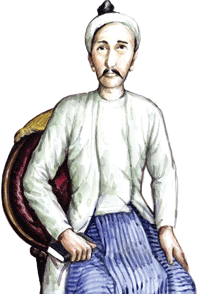Ruling the Rulers
Efforts to limit the powers of Burma’s absolute monarchs failed. So did the monarchy
THROUGHTOUT Asia, the middle of the 19th century was a period of political turmoil, as Western imperial powers pressed in upon countries that were subject to various forms of pre-modern rule. Burma was no exception, as it was forced to come to terms with a nation that was not only militarily superior, but also politically more advanced.
Under the country’s last two monarchs, King Mindon (1853-78) and King Thibaw (1878-85), there were attempts to reform Burmese polity in the face of growing external challenges. At the center of these efforts was Yaw Atwinwun U Hpo Hlaing, the author of “Rajadhammasangaha,” a treatise which would have laid the basis for a constitutional monarchy in Burma, and which, in the words of respected scholar Maung Htin, “might have kept King Thibaw in the enjoyment of his throne.”
 |
| Yaw atwinwun Hop Hlaing warned against the danger of absolute power. (Illustration: Harn lay/ The Irrawaddy) |
Hpo Hlaing was born in 1830 in Ywapale, a village in the upper part of the central Burmese district of Myingyan. His father, the Lord of Yenanchaung, was a royal minister of King Tharawaddy. When Hpo Laing was 16 years old, his father was accused of disloyalty and killed by the king during a meeting of the royal council, the Hluttaw.
This incident, which undoubtedly steeled his later determination to limit the absolute powers of the kings who ruled Burma, could easily have cost him his life, if not for the intervention of Princess Mahar Devi, daughter of King Tharawaddy. As her foster child, he survived to become a valued adviser to Prince Mindon when he rebelled against his half-brother, King Pagan, in 1852. Mindon assumed power the following year, becoming Burma’s penultimate king at a time when the British had completed their annexation of Lower Burma following the Second Anglo-Burmese War.
As a trusted counselor who had helped King Mindon to seize power, Hpo Hlaing received numerous titles and honors. He was named governor, or atwinwun, of Yaw and elevated to the rank of noble. He also served as minister of the interior and was entrusted with control over foreign policy matters. But his most important task was that of overseeing administrative reforms. In this, he had the support of the brother and heir apparent of King Mindon, Prince Kanaung, who together with Hpo Hlaing initiated a series of reforms designed to put the kingdom on a more equal footing in its dealings with the British.
Although he enjoyed the new king’s favor, Hpo Hlaing’s independent character sometimes brought him into conflict with King Mindon. Once, when he criticized the king for having so many wives, he was threatened with the same spear that had been used to kill his father. He stood his ground, however, saying that the loss of his own life was insignificant compared to the disasters that would befall the country if the king were permitted to have his own way in all things.
Despite such confrontations, which on several occasions led to Hpo Hlaing’s dismissal and imprisonment, reform efforts continued under King Mindon, even after the murder of Prince Kanaung in 1866. However, plans to implement far-reaching changes were not actively pursued until after King Mindon’s death in 1878. It was in the following year that Hpo Hlaing submitted his “Rajadhammasangaha”—variously translated as “A Collection of Norms for Kingship” or “Civil Society under Monarchy”—to Mindon’s successor, King Thibaw. It was, in effect, a draft constitution that would set the rules for Burma’s rulers.
Under the guidelines proposed in the “Rajadhammasangaha,” the king would draw a salary and reign as a constitutional monarch, while the affairs of state would be conducted by a bicameral parliament of the people and the aristocracy. Members of the legislature would be drawn from the towns and villages of the country in the case of the lower house and from the ranks of the nobility in the case of the upper house.
1 | 2 next page »
